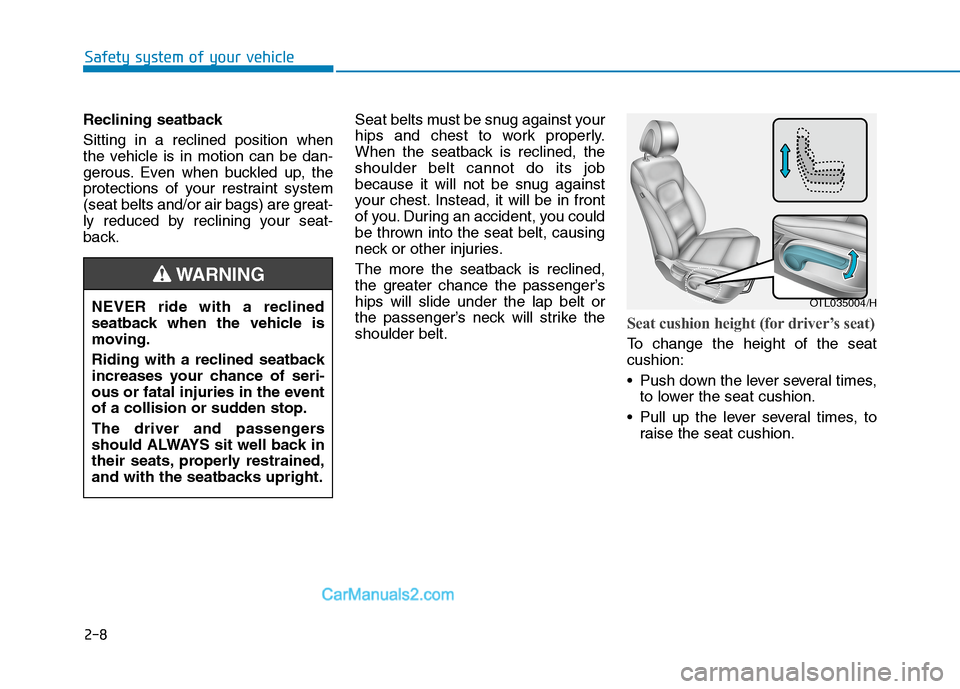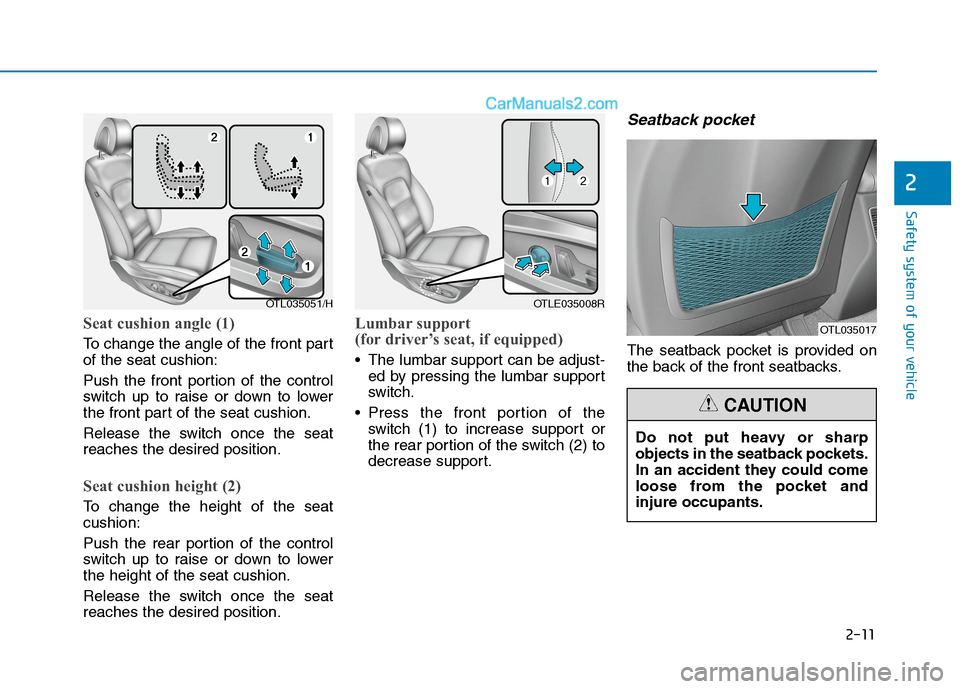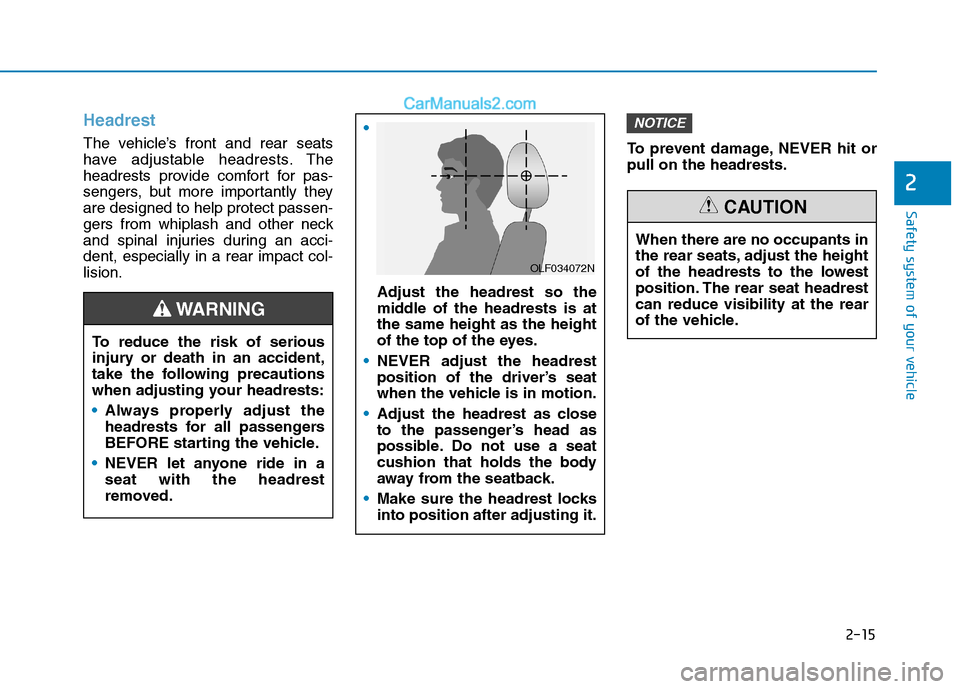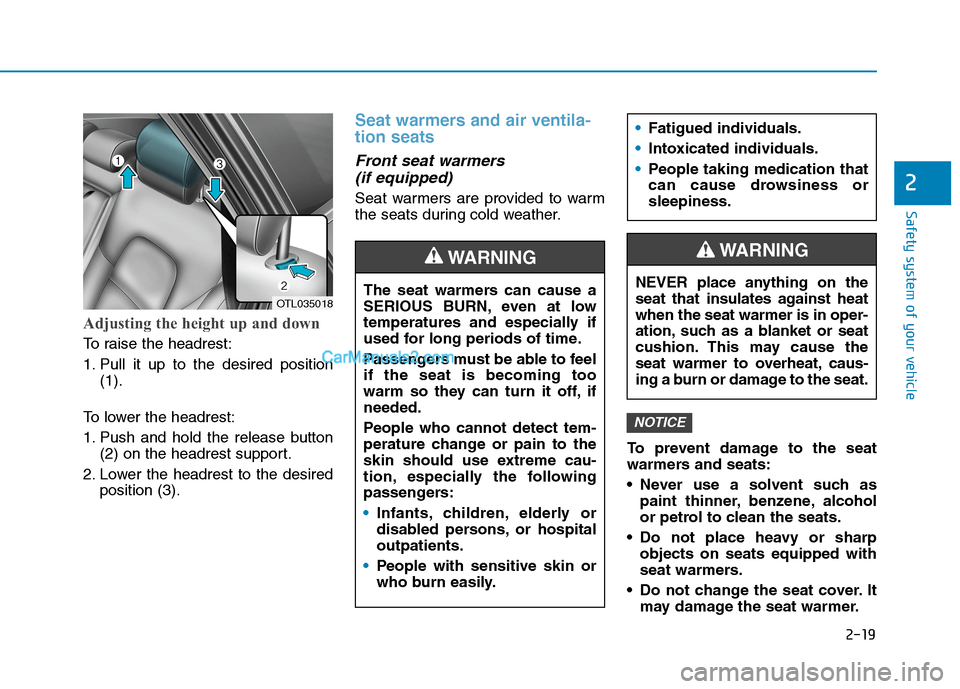Page 25 of 637
2-4
Safety system of your vehicle
S SE
EA
AT
TS
S
OTL035001R
Front seats
(1) Forward and rearward
(2) Seatback angle
(3) Seat cushion height (Driver’s seat)
(4) Lumbar support (Driver’s seat)*
(5) Seat warmer*
(6) Air ventilation seat*
(7) Headrest
Rear seats
(8) Seatback angle and folding
(9) Headrest
(10) Armrest
(11) Seat warmer*
* : if equipped
Power seat
Manual seat
Page 29 of 637

2-8
Safety system of your vehicle
Reclining seatback
Sitting in a reclined position when
the vehicle is in motion can be dan-
gerous. Even when buckled up, the
protections of your restraint system
(seat belts and/or air bags) are great-
ly reduced by reclining your seat-
back.Seat belts must be snug against your
hips and chest to work properly.
When the seatback is reclined, the
shoulder belt cannot do its job
because it will not be snug against
your chest. Instead, it will be in front
of you. During an accident, you could
be thrown into the seat belt, causing
neck or other injuries.
The more the seatback is reclined,
the greater chance the passenger’s
hips will slide under the lap belt or
the passenger’s neck will strike the
shoulder belt.
Seat cushion height (for driver’s seat)
To change the height of the seat
cushion:
Push down the lever several times,
to lower the seat cushion.
Pull up the lever several times, to
raise the seat cushion. NEVER ride with a reclined
seatback when the vehicle is
moving.
Riding with a reclined seatback
increases your chance of seri-
ous or fatal injuries in the event
of a collision or sudden stop.
The driver and passengers
should ALWAYS sit well back in
their seats, properly restrained,
and with the seatbacks upright.
WARNING
OTL035004/H
Page 32 of 637

2-11
Safety system of your vehicle
2
Seat cushion angle (1)
To change the angle of the front part
of the seat cushion:
Push the front portion of the control
switch up to raise or down to lower
the front part of the seat cushion.
Release the switch once the seat
reaches the desired position.
Seat cushion height (2)
To change the height of the seat
cushion:
Push the rear portion of the control
switch up to raise or down to lower
the height of the seat cushion.
Release the switch once the seat
reaches the desired position.
Lumbar support
(for driver’s seat, if equipped)
The lumbar support can be adjust-
ed by pressing the lumbar support
switch.
Press the front portion of the
switch (1) to increase support or
the rear portion of the switch (2) to
decrease support.
Seatback pocket
The seatback pocket is provided on
the back of the front seatbacks.
OTL035051/H
OTL035017
OTLE035008R
Do not put heavy or sharp
objects in the seatback pockets.
In an accident they could come
loose from the pocket and
injure occupants.
CAUTION
Page 36 of 637

2-15
Safety system of your vehicle
2
Headrest
The vehicle’s front and rear seats
have adjustable headrests. The
headrests provide comfort for pas-
sengers, but more importantly they
are designed to help protect passen-
gers from whiplash and other neck
and spinal injuries during an acci-
dent, especially in a rear impact col-
lision.To prevent damage, NEVER hit or
pull on the headrests.
NOTICE
When there are no occupants in
the rear seats, adjust the height
of the headrests to the lowest
position. The rear seat headrest
can reduce visibility at the rear
of the vehicle.
CAUTION
To reduce the risk of serious
injury or death in an accident,
take the following precautions
when adjusting your headrests:
Always properly adjust the
headrests for all passengers
BEFORE starting the vehicle.
NEVER let anyone ride in a
seat with the headrest
removed.
Adjust the headrest so the
middle of the headrests is at
the same height as the height
of the top of the eyes.
NEVER adjust the headrest
position of the driver’s seat
when the vehicle is in motion.
Adjust the headrest as close
to the passenger’s head as
possible. Do not use a seat
cushion that holds the body
away from the seatback.
Make sure the headrest locks
into position after adjusting it.
WARNING
OLF034072N
Page 37 of 637
2-16
Safety system of your vehicle
Front seat headrests
The driver’s and front passenger’s
seats are equipped with adjustable
headrests for the passengers safety
and comfort.
Forward and rearward adjustment
The headrest may be adjusted for-
ward to 3 different positions by
pulling the headrest forward to the
desired detent. To adjust the head-
rest to it’s furthest rearwards posi-
tion, pull it fully forward to the farthest
position and release it.
Adjusting the height up and down
To raise the headrest:
1. Pull it up to the desired position
(1).
To lower the headrest:
1. Push and hold the release button
(2) on the headrest support.
2. Lower the headrest to the desired
position (3).
OLMB033009
OTL035014OTL035009
Page 39 of 637
2-18
Safety system of your vehicle
To reinstall the headrest :
1. Recline the seatback.
2. Put the headrest poles (2) into the
holes whilst pressing the release
button (1).3. Adjust the headrest to the appro-
priate height.
4. Recline the seatback (4) with the
seatback angle lever or switch (3).
Rear seat headrests
The rear seats are equipped with
headrests in all the seating positions
for the passenger’s safety and com-
for t.
OLMB033016
Always make sure the headrest
locks into position after rein-
stalling and adjusting it proper-
ly.
WARNING
OTL035012R
■Type A
OTLE035013R
■Type B
Page 40 of 637

2-19
Safety system of your vehicle
2
Adjusting the height up and down
To raise the headrest:
1. Pull it up to the desired position
(1).
To lower the headrest:
1. Push and hold the release button
(2) on the headrest support.
2. Lower the headrest to the desired
position (3).
Seat warmers and air ventila-
tion seats
Front seat warmers
(if equipped)
Seat warmers are provided to warm
the seats during cold weather.
To prevent damage to the seat
warmers and seats:
Never use a solvent such as
paint thinner, benzene, alcohol
or petrol to clean the seats.
Do not place heavy or sharp
objects on seats equipped with
seat warmers.
Do not change the seat cover. It
may damage the seat warmer.
NOTICE
The seat warmers can cause a
SERIOUS BURN, even at low
temperatures and especially if
used for long periods of time.
Passengers must be able to feel
if the seat is becoming too
warm so they can turn it off, if
needed.
People who cannot detect tem-
perature change or pain to the
skin should use extreme cau-
tion, especially the following
passengers:
Infants, children, elderly or
disabled persons, or hospital
outpatients.
People with sensitive skin or
who burn easily.
Fatigued individuals.
Intoxicated individuals.
People taking medication that
can cause drowsiness or
sleepiness.
WARNING
NEVER place anything on the
seat that insulates against heat
when the seat warmer is in oper-
ation, such as a blanket or seat
cushion. This may cause the
seat warmer to overheat, caus-
ing a burn or damage to the seat.
WARNING
OTL035018
Page 49 of 637

2-28
Safety system of your vehicle
Height adjustment
You can adjust the height of the
shoulder belt anchor to one of four
different positions for maximum com-
fort and safety.
The shoulder portion should be
adjusted so it lies across your chest
and midway over your shoulder near-
est the door, not over your neck.To adjust the height of the seat belt
anchor, lower or raise the height
adjuster into an appropriate position.
To raise the height adjuster, pull it up
(1). To lower it, push it down (3) whilst
pressing the height adjuster button
(2).
Release the button to lock the
anchor into position. Try sliding the
height adjuster to make sure that it
has locked into position.
To release your seat belt:
Press the release button (1) in the
locking buckle.
When it is released, the belt should
automatically draw back into the
retractor. If this does not happen,
check the belt to be sure it is not
twisted, then try again.
OTL035026
■Front seat
OJS038070AU
Position the lap portion of the
seat belt as low as possible
across your hips, not on your
waist, so that it fits snugly.
This allows your strong pelvic
bones to absorb the force of
the crash, reducing the
chance of internal injuries.
Position one arm under the
shoulder belt and the other
over the belt, as shown in the
illustration.
Always position the shoulder
belt anchor into locked posi-
tion at the appropriate height.
Never position the shoulder
belt across your neck or face.